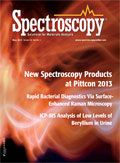Article
Spectroscopy
Spectroscopy
Appendix VI: Mass Spectrometry
Author(s):
Additional information from the mass spectrometry section of the Pittcon Review article.
Manufacturer: Excelllims Corporation
Product name: High Performance Ion Mobility Spectrometer (HPIMS)
Ion Mobility Spectrometer
New this year: IA3100, a hyphenated HPLC-HPIMS system that provides two-dimensional separation
Used for: Lab, process, handheld analysis
Dimensions: 45 cm wide × 51 cm deep × 46 cm tall.
Measurement Mode: Ion mobility
Features: several user-changeable ionization sources are available: DirectsprayTM electrospray ionization source, infusion ionization source, a thermal desorber is also available, These various sample introduction methods allow for for quick introduction of a liquid sample using disposable or common micro-syringes, or a built-in electrospray needle connect to an autosampler or reaction vessel. The thermal desorber allows for analysis of solid samples. IA3100 combines HPLC and HPIMS for the unique ability to separate molecules based on polarity, size, and shape in a single analysis.
Software: 21CFR11 compliant, cGMP compliant, Compatible with other manufacturers' equipment.
Suggested Applications: food and drug safety testing, and pharmaceutical/chemical process analysis, such as cleaning validation, dissolution testing, content uniformity, surfactants and reaction monitoring.
Primary benefits: rapid results with minimal method development. HPIMS allows for analysis non-volatiles, compounds without UV chromophores, surfactants, and isomers. Unique features: can be used as a standalone analytical technique, or can be paired with HPLC or MS for two-dimensional separation. IMS separation is orthogonal to HPLC. Can be combined with MAss Spec to produce multi-dimensional data. HPIMS-MS can identify the mass of a molecule as well as provide information about its size and shape
Manufacturer: Hiden Analytical Limited
Product name: QGA Atmospheric Gas Analyser
Mass Spectrometer
New this year: Extended sampling range 10 mbar – 30 bar, QGA Pro spectral deconvolution program
Used for: Lab, process analysis
Special Features: High Sensitivity: detection to 100 PPB, <300 ms response time to changes in gas concentrations, Fast data acquisition (up to 500 measurements per second).
Software: MASsoft Professional, QGA Professional
May be used in other equipment.
Suggested Applications: Thermal Analysis, Exhaust Gas Analysis, Gas Purity Monitoring, Gas Reaction Studies, Fuel Cell Reactions Studies, Contamination Studies, Fermentation Analysis, Environmental Gas Analysis, Catalysis Studies / Reaction Kinetics
Unique features: APSI-MS soft ionization mode, QGA Pro Quantitative gas analysis program with automatic calibration
Manufacturer: Hiden Analytical Limited
Product name: HPR-60 MBMS Molecular Beam Sampling Mass Spectrometer
Mass Spectrometer
New this year: Direct sampling of neutrals, positive and negative ions and ion energies from reactive processes to 5 bar.
Used for: Lab analysis
Measurement Mode: Analysis of neutral species, positive and negative ions and ion energies
Special Features: Sensitivity to 5 PPB, analogue/pulse counting analysers, to 2500 amu,
Mass Range: 50, 300, 500, 1000 or 2500 amu, Detector: Off-axis Positive and Negative Ion Pulse Counting Single Channel Electron multiplier, 7 decade continuous dynamic range,
Energy Filter: Pole Bias, Bessel Box or 45 degree sector field options, 20, 100, 1000 and 5000 mbar sampling pressure options.
Software: MASsoft Professional
Compatible with other manufacturers' equipment
Suggested Applications: Reaction Kinetics, Plasma Diagnostics, Combustion studies: flame ionisation analysis, Catalysis studies, CVD / MOCVD – Diamond growth studies, Flash Desorption studies, Atmospheric Glow discharge analysis, Cluster Analysis
Primary benefits: Multiple choice of vacuum, detector and process interface types for diverse research requirements
Unique features: Sampling Pressure Range: 10–4 mbar up to 5 bar, Supersonic Molecular Beam, collisionless molecular beam analysis of high-speed, atmospheric pressure processes
Manufacturer: IONICON Analytik GmbH
Product name: PTR-TOF 8000
Mass Spectrometer
Proton Transfer Reaction – Mass Spectrometer, with Selective Reagent Ionization.
New this year: Kr+ and Xe+ available as reagent ions with PTR-MS for the first time.
Used for: Lab, process, Hand-held/portable operation
Special Features: nearly all volatile substances can now be detected in low concentrations and online. The SRI (Selective Reagent Ionization) feature makes H3O+, NO+ and O2+, Kr+ and Xe+ available and can now also be used for SRI-MS ionization.
Software: proprietary, Available as separate product.
Suggested Applications: Measurement of low concentrated (pptv-range) VOCs. Used in environmental research (atmospheric chemistry, BTEX, BVOC studies), food & flavor science (aroma, fragrance and flavor quantification), illicit substances detection (CWAs, TICs, explosives)
Primary benefits: Kr+ can transfer charge to nearly all volatiles, including those hydrocarbons which cannot be detected via proton transfer reactions. IONICON instrument is now capable of detecting nearly all volatile compounds
Unique features: High-Resolution time of flight mass spectrometer (mass resolution up to 8000), response time down to 100 ms and detection limit in the single-digit pptv-range
Manufacturer: IonSense, Inc.
Product name: DART GSX System
Product type: Mass spectrometer
New this year: This is the first ambient ionization system for a GC/MS instrument: Direct Analysis in Real Time (DART) for Agilent GC/MSD instruments
Used for: Lab analysis
If portable, specify dimensions:
Measurement Mode: mass spectrometry
Special Features: Little or no sample preparation, results in seconds, and easy to interpret spectra
Software Available as separate product, compatible with other manufacturers' equipment
Suggested Applications: Food safety and quality, and drugs of abuse testing
Primary benefits: For the first time, customers with GC/MS instruments can enjoy the benefits of DART
Unique features: The DART GSX System can be fitted to an existing Agilent GC/MSD instrument or it can be supplied as a complete system with a new or refurbished Agilent GC/MSD.
Manufacturer: Photonis USA
Product name: IMS Analyzer
Product type: An Ion Mobility Spectrometry Analyzer to be coupled with a Mass Spectrometer or for use in stand-alone applications.
New this year: The unit combines PHOTONIS' patented Resistive Glass products with a new robust ion gate technology to create an IMS analyzer which improves resolution and simplifies serviceability.
Used for: Lab & Process analysis
Measurement Mode: IMS resolving power
Specialty accessory description: Drift tubes and other components made from Resistive Glass combine to replace conventional lens assemblies in this new IMS analyzer, resulting in significantly higher resolving power when compared to currently available commercial IMS instruments. The new, compact platform is designed to be scaled or customized to interface with a wide variety of instruments to provide simple IMS analysis that can be performed at room temperature.
Available as separate product. May be used in other equipment. Compatible with other manufacturers' equipment.
Suggested Applications: Pharmaceutical Safety, Homeland security, contaminant analysis
Primary benefit(s) to the spectroscopist: (compared with current products): Room temperature analysis, High resolving power (64-150) for fast results, Simplified Ion Gate is robust
Unique features: Customizable to interface with most MS units, Patented Resistive Glass Drift Tubes increase Ion Throughput, Room Temperature Analysis, Simplified Ion Gate
Manufacturer: Shimadzu
Product name: GCMS-TQ8030
Triple Quadrupole Gas Chromatograph Mass Spectrometer (GC/MS/MS)
New this year: The GCMS-TQ8030 marks Shimadzu's entrance into the triple-quad GC/MS/MS market.
Used for: Lab analysis
Specialty accessory description: It is the only GC/MS/MS capable of running all triple quadrupole operational modes. Scan speeds of 20,000 u/second. UFsweeper technology reduces collision cell length. Front-access ion source for maintenance, optimized collision energy for each MRM transition, 600 MRM transitions/second
Suggested Applications: Food safety (residual pesticides, toxins), environmental (soil/water analysis, pesticides), toxicology/forensics, pharmaceuticals
Primary benefits: scan speed of 20,000 u/sec, GC/MS/MS capable of running all triple quadrupole operational modes, UFsweeper technology reduces collision cell length, ecology mode minimizes gas usage.
Unique features: 600 MRMs/second, 20,000 u/sec scan speed, individual quadrupole resolution on Q1 and Q3 for each compound.
Manufacturer: Shimadzu
Product name: LCMS-8040 Triple Quadrupole Liquid Chromatograph Mass Spectrometer
Mass Spectrometer (LC–MS-MS)
New this year: newly improved ion optics, integrating two multi-pole RF ion guides
Special Features: the world's fastest switching (15 msec high-speed scanning (15,000 u/sec), 555 MRMs per second with UFsweeper II collision cell technology, improved ion optics (UF-Lens), UFsweeper II technology.
Suggested Applications: Foods (ingredient analysis, toxins, pesticides), Pharmaceuticals (trace impurity analysis, toxicity testing, synthetic compounds), Forensics (doping testing, drugs of abuse), Biomarker Discovery
Primary benefits: minimum ion losses, higher sensitivity for MRMs,
Unique features: 555 MRMs/second, 15,000 u/sec scan speed, Polarity switching speed of 15 msec, UFsweeper II collision cell technology, Method packages.
Newsletter
Get essential updates on the latest spectroscopy technologies, regulatory standards, and best practices—subscribe today to Spectroscopy.




